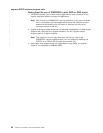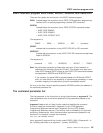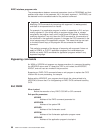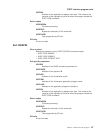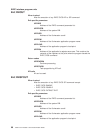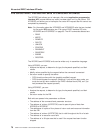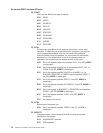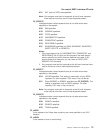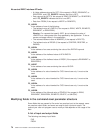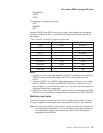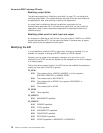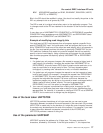
The command-level parameter structure
The command-level parameter structure consists of a series of addresses. The first
address points to the EXEC interface descriptor (EID), which consists of a bit string
that describes the type of request and identifies each keyword specified with the
request. The remaining addresses point to pieces of data associated with the
request. (For example, the second address always points to the file name.)
Only the first 8 addresses and the last address can be referenced by the user
exit. The ninth through eleventh addresses are reserved for CICS internal use.
You can examine the EID to determine the type of request and the keywords
specified. You can examine the other parameters in the list to determine the values
of the keywords. You can also modify values of keywords specified on the request.
(For example, you could change the name of the file involved in the request.)
End of parameter list indicator
The high-order bit is set on in the last address set in the parameter list to
indicate that it is the last one in the list. On return from your user exit program,
CICS scans the parameter list for the high-order bit to find the last parameter.
Therefore, if you modify the length of the parameter list, you must also reset
the high-order bit to indicate which is the new last address.
The original parameter list, as it was before XFCREQ was invoked, is restored after
the completion of XFCREQC. It follows that the execution diagnostic facility (EDF)
displays the original command before and after execution. EDF does not display
any changes made by the exit.
The UEPCLPS exit-specific parameter
The UEPCLPS exit-specific parameter is included in both exit XFCREQ and exit
XFCREQC. It is the address of the command-level parameter structure. The
command-level parameter structure contains 12 addresses, FC_ADDR0 through
FC_ADDRB. It is defined in the DSECT FC_ADDR_LIST, which you should copy
into your exit program by including the statement COPY DFHFCEDS.
The command-level parameter list is made up as follows:
FC_ADDR0
is the address of a 9-byte area called the EID, which is made up as follows:
FC_GROUP
FC_FUNCT
FC_BITS1
FC_BITS2
FC_EIDOPT5
FC_EIDOPT6
FC_EIDOPT7
FC_EIDOPT8
The name of the DSECT mapping the EID is FC_EID.
FC_GROUP
Always X'06', indicating that this is a file control request.
file control EXEC interface API exits
Chapter 1. Global user exit programs 71




